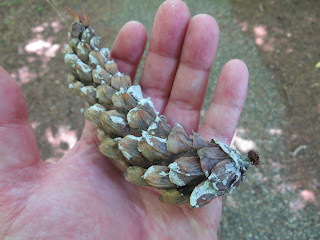 |
| Copper Beach at Brandon Country Park |
Giant wood wasps (or horntails as they are also known) are one of the most scary-looking insects that are on my list this year. They are large, wasp-like creatures with long stinger-like things protruding from the rear. Despite the menacing appearance, they are actually harmless. The long 'stinger' is actually an ovipositor which is used to lay it's eggs deep within a trunk of a pine tree. It is indeed a fascinating creature and one I wouldn't mind seeing as part of my bug hunt this year. As horntails prefer pine trees, the best place to look would be in a pine forest. So Thetford Forest, one of England's largest pine forests, should be an ideal place for them. Today, I have travelled to Brandon Country Park on the hunt for this giant wasp.
 |
| Ephialtes manifestator |
Unfortunately, despite checking every pine tree I could find, both standing and fallen, I was not able to find myself a horntail. But I did find something that was a good replacement. Crawling around a tiny piece of pine on the forest floor was a small ichneumon wasp with an ovipositor that was twice as long as it's body. There are around 2,300 species of these wasps that paralyse other insects to lay their eggs within them, but I think this is a female
Ephialtes manifestator. This species targets the larvae of other wasps, like horntails, that live within the wood of a pine trunk. They use that incredibly long ovipositor to reach the larvae inside the tree by drilling into the wood. I also found a few similar looking wasps without that long ovipositor buzzing around a different tree covered in holes. Mum was brave enough to catch a couple for me, but I am not sure if these are males of the same species or a completely different species entirely. I'll leave that to an expert to decide.
 |
| A male one or something completely different? |
 |
| Orange Footman |
 |
| Solder beetle? |
 |
| Columbine |
While searching for horntails and other wasps, we were following a tree trail that featured 20 trees from around the world for us to see. This included...
 |
| Box |
 |
| Copper Beech |
 |
| Monterey Pine |
 |
| Western Yellow |
 |
| Grand Fir |
 |
| Deodar Cedar |
 |
| European Larch |
 |
| Monkey Puzzle |
 |
| Wellingtonia or Giant Redwood |
 |
| Blue Atlas Cedar |
 |
| Fern-leaved Beech |
 |
| Delaways Silver Fir |
 |
| Beech |
 |
| Horse Chestnut |
 |
| Tree of Heaven |
 |
| Douglas Fir |
 |
| Colorado White Fir |

 |
| Coastal Redwood |
 |
| The banana-shaped pinecone of a Bhutan |
 |
| Holly |
I also heard a firecrest and saw treecreeper preening itself halfway up one of the 20 highlighted trees. At the only pond in the park, we saw plenty of roach swimming near the shallows as well as red damselflies and flag irises around the pond's edge.
 |
| Treecreeper |
 |
| The pond at Brandon Country Park |
 |
| Large Red Damselfly |
 |
| Yellow Flag Iris |
 |
| Grey Squirrel |
 |
| Handkerchief Tree |
After lunch, we checked out the handkerchief tree in the walled garden. The flowers on this Asian tree looks just like handkerchiefs hanging on the tree to dry. While in the garden, I saw a few interesting insects. The real highlight here, though, was finding a really special moth. Broad-bordered bee hawk-moths are summer visitors from Southern Europe. They are much scarcer than their cousins the hummingbird hawk-moth, but I have seen one before a couple of years ago at Holt Country Park. They are day-flying moths that feed on rich nectar-filled flowers, hovering at a distance with their long proboscis sucking up the nectar like a straw. Finding this wonderful insect was a real surprise and more than makes up for not finding a horntail today.
 |
| The flowers of the Handkerchief Tree |

 |
| Broad-bordered Bee Hawk-moth |
 |
| Hoverfly |
 |
| Small Copper |




















































No comments:
Post a Comment